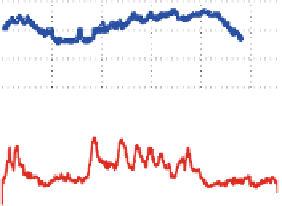Biomedical Engineering Reference
In-Depth Information
Tem
pe
rature
b
20
19
18
a
c
Computer
Control
EM CCD
camera
18.5
18
Control
Data acquisition
17.5
Synchronize
Hard disk
recorder
17
3
6
9
12
time (min
)
Dichroic
mirror
d
Hg lamp
Camera
4
Computer
Dichroic
mirror
3
Galvano shutter
2
Control
Data acquisition
3
6
9
12
time (min)
Objective lens
YFP
/CFP
e
3.8
Thermal gradient
Motorized stage
2.7
halogen lamp
1.5
Fig. 1.4
An example of simultaneous measurements for behavior, thermal stimulus, and neuronal
activity. (
a
) Tracking and imaging system which combine calcium imaging and automated stage
regulation. (
b
) A trail of
C. elegans
(
white line
) on an agar plate with thermal gradient. (
c
)
Temperature time course calculated by the data shown in (
b
). (
d
) Time course of YFP/CFP of
Cameleon expressed in AFD thermosensory neuron. (
e
) Mapping of YFP/CFP in (
d
) on the trail of
animal shown in (
b
)
1.6
Conclusion
Many advantages of
C. elegans
studies are utilized for behavioral analysis as
introduced in this chapter. In addition, several other approaches are available and
have been developed enthusiastically. Same as
Drosophila
, zebra fi sh, and mouse
research, technique of electrophysiology could be also used for
C. elegans
(Piggott
et al.
2011
; Ramot et al.
2008b
). Recent progress of microfl uidic devices enables to
expand experimental designs; it could be used for both population (Albrecht and
Bargmann
2011
) and individual (Chronis et al.
2007
) assay according to the research
context and particularly useful for the experiments related to odorant sensing.
Optogenetics is most suitable with
C. elegans
studies because of transparent body
and compatibility with genetics (Ezcurra et al.
2011
; Kuhara et al.
2011
; Lindsay
et al.
2011
; Narayan et al.
2011
). Using these updating techniques effi ciently, studies
of
C. elegans
continue to promote neuroethology.






























































































































































































